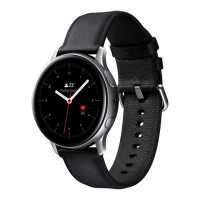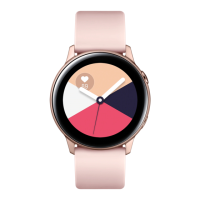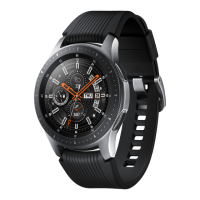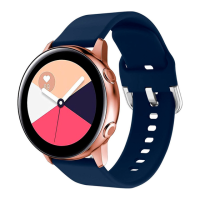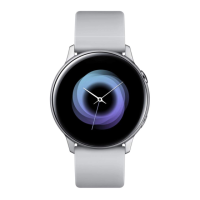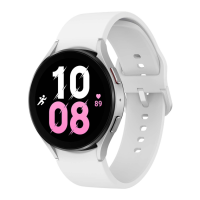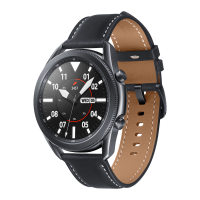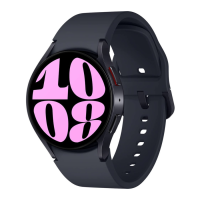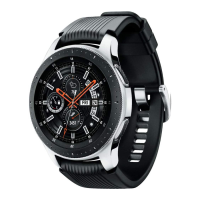
Do you have a question about the Samsung Galaxy Watch SM-R800 and is the answer not in the manual?
| Model Number | SM-R800 |
|---|---|
| Display Type | Super AMOLED |
| Display Size | 1.3 inches |
| Resolution | 360 x 360 pixels |
| Protection | Corning Gorilla Glass DX+ |
| Chipset | Exynos 9110 |
| CPU | Dual-core 1.15 GHz Cortex-A53 |
| Internal Storage | 4GB |
| RAM | 768MB |
| Battery Capacity | 472 mAh |
| Connectivity | Wi-Fi 802.11 b/g/n, Bluetooth 4.2, NFC |
| Sensors | Accelerometer, gyro, heart rate, barometer |
| Weight | 63g |
| Operating System | Tizen-based wearable OS |
| Water Resistance | 5ATM + IP68 |
| Dimensions | 46 x 49 x 13 mm |
Overview of the Galaxy Watch's features and capabilities, including its smart functions.
Essential safety and usage information to ensure proper operation and avoid device damage.
Guidelines for preserving the device's water and dust resistance to prevent damage.
Information on device overheating warnings, instructional icons, and cleaning guidelines.
Advisories regarding potential skin sensitivities or allergies to materials used in the Galaxy Watch.
Details on the device's physical components and the items included in the package.
Diagram illustrating the physical parts of the SM-R800 and SM-R805F models.
Diagram illustrating the physical parts of the SM-R810 and SM-R815F models.
Explanation of the functions of the Home/Power and Back keys on the Galaxy Watch.
Information on the wireless charging dock, battery, and initial charging procedures.
Step-by-step instructions for charging the Galaxy Watch using the wireless charging dock.
How to check charging status via LED and important tips for battery charging.
How to activate and use power saving mode to extend battery life.
Instructions on how to wear the Galaxy Watch for optimal function and comfort.
Tips for band maintenance and instructions on how to replace the watch band.
Instructions for powering the Galaxy Watch on, off, and performing a restart.
Steps to install the Galaxy Wearable app and connect the watch via Bluetooth.
Detailed steps for establishing a Bluetooth connection between the watch and a mobile device.
Enabling the watch's mobile network for standalone calls and messages.
Guide for connecting to a new phone and setting up remote connection features.
Instructions for operating the Galaxy Watch independently without a mobile device.
Overview of screen layout, adding, moving, and removing widgets.
Methods to turn the screen on/off and switch between watch and app screens.
How to open, close apps, and return to the previous screen.
Instructions on using the bezel for navigation and scrolling through screens.
Using the bezel to select items and adjust values like volume or brightness.
Details on using the phone/alarm feature with the bezel and touchscreen precautions.
How to perform tapping and tapping-and-holding gestures on the touchscreen.
Using drag and double-tap gestures for interaction and zooming.
How to access and use the Quick Panel for status and settings.
Explanation of indicator icons and quick setting icons displayed on the Quick Panel.
How to add or remove icons from the Quick Panel for personalized access.
Adding icons, activating power saving, flight mode, and accessing the volume menu.
Managing Do Not Disturb, Always On display, brightness, and Wi-Fi connections.
Activating NFC, using Find My Phone, managing mobile networks, and battery menu.
Connecting Bluetooth headsets, activating modes, and using location features.
Controlling music playback, activating goodnight mode, and touch sensitivity.
Setting up and using the screen lock feature for device security.
Viewing the watch screen and changing the watch face.
Personalizing watch faces with photos and enabling the Always On feature.
Activating Watch Only mode and managing the notification panel.
How to view details of incoming notifications and delete them.
Selecting apps for notifications and introduction to text input methods.
Using voice input for messages and tips for improving voice recognition accuracy.
Using emoticons and handwriting input mode or the keyboard for text entry.
Switching input modes, languages, and using the on-screen keyboard.
Overview of sending and receiving messages on the Galaxy Watch.
Step-by-step guide for composing and sending text messages from the watch.
Making and receiving calls using the Galaxy Watch's phone functionality.
How to reject incoming calls and view missed call notifications.
Methods for making calls and available options during an active call.
Managing contacts and switching to a Bluetooth headset for calls.
Adding contacts, widgets, and personal medical information for emergencies.
How to set up and use Samsung Pay for convenient and secure payments.
Introduction to Samsung Health for tracking activity, sleep, and health data.
Proper watch placement for accurate heart rate and exercise measurement.
Important tips and precautions for accurate heart rate measurement and device usage.
How to record and track daily calorie consumption for weight management.
Measuring step count and distance walked, with tips for accuracy.
Setting step targets, alarms, and measuring floors climbed.
Recording and tracking exercise information and calories burned.
Steps to start exercises, customize information screens, and set options.
Viewing exercise stats, swimming mode features, and accuracy considerations.
Logging multiple exercises and performing repetitive exercises with guidance.
Setting targets and tracking repetitions for specific exercises.
Customizing exercise display and enabling automatic exercise detection.
Measuring and analysing sleep patterns for better rest and health.
Setting sleep report notifications and precautions for heart rate measurement.
Steps to measure heart rate directly and view historical data.
Automatic heart rate tracking and measuring stress levels through breathing exercises.
Measuring stress levels and viewing historical stress data.
Reducing stress via breathing and tracking daily food intake and calories.
Recording calories consumed and setting daily calorie targets.
Recording and tracking daily water consumption and setting consumption targets.
Recording and tracking daily coffee consumption and setting consumption limits.
Comparing step counts with friends and configuring exercise-related settings.
Important notes regarding Samsung Health data, features, and regional availability.
Using GPS for location tracking and measuring altitude and atmospheric pressure.
Measuring current altitude and performing manual calibration for accuracy.
Measuring atmospheric pressure and configuring alti-barometer settings.
Playing music saved on the watch and importing music from a mobile device.
Playing music stored on the watch or from a mobile device.
Listening to music without a mobile device and creating reminders.
Viewing reminder alarms, completing/deleting reminders, and managing calendar events.
Introduction to Bixby and methods for launching the voice assistant.
How to use Bixby voice commands and tips for better voice recognition.
Setting Bixby language, viewing weather, and setting alarms.
Stopping/deleting alarms and creating/deleting world clocks.
Transferring images between the mobile device and the Galaxy Watch.
How to view, zoom, and delete images stored on the watch.
Catching up on news categories and selecting a region for news updates.
Locating a misplaced mobile device or Galaxy Watch using the respective features.
Remotely controlling the watch and setting up SOS messages and emergency contacts.
Activating SOS calls, setting delays, sending messages, and viewing location.
Reading emails on the watch and using it as a PPT controller via Bluetooth.
Steps to connect the watch to a computer for controlling presentations.
Configuring wrap-up and interval alerts for presentations.
Using Samsung Flow to connect and unlock computers/tablets.
Steps for connecting devices and unlocking computers/tablets with Samsung Flow.
Downloading apps/watch faces and customizing basic settings.
Customizing watch faces and adjusting sound and vibration settings.
Adjusting display brightness, screen timeout, and advanced features.
Configuring bezel wake-up, water lock, touch sensitivity, and various modes.
Connecting to mobile devices and Bluetooth headsets via Bluetooth.
Managing mobile network connections, including auto on/off and always on settings.
Activating and connecting to Wi-Fi networks for internet access.
Using NFC for payments and device interactions.
Setting alerts for disconnection and activating flight mode.
Tracking data usage, managing location permissions, and app order.
Managing app permissions, call, and message settings.
Securing the Galaxy Watch with lock features and managing security updates.
Managing Samsung account, backing up data, and configuring accessibility options.
Configuring text input, text-to-speech, and date/time settings.
Managing language, resetting the device, and selecting battery modes.
Viewing device information and connecting to a new mobile device.
Restoring or syncing watch data with a mobile device.
Overview of the Galaxy Wearable app for watch management and customization.
Using app options like Disconnect, User Manual, and viewing INFO/ABOUT WATCH.
Accessing payment, downloading faces/apps, and viewing health data via the app.
Configuring notification settings for received alerts on the watch.
Uninstalling, reordering, hiding, and customizing apps within the wearable app.
Managing widgets and adjusting sound and vibration settings through the app.
Customizing display settings and advanced features via the app.
Transferring music and image files to the Galaxy Watch.
Setting up SOS requests and using Find My Watch for lost device recovery.
Managing watch connection, accessing Galaxy Apps, Samsung Health, and Samsung Pay.
Controlling smart devices, managing networks, and viewing watch information.
Updating the Galaxy Watch software wirelessly through the wearable app.
Backing up and restoring watch data and settings using the wearable app.
Overview of watch features and using it as a daily planner for schedules.
Viewing schedules and reminders, and information about alarm settings.
Customizing features based on lifestyle and receiving daily briefings.
Launching apps based on location/time and activating goodnight mode for sleep.
Using the dual clock feature when traveling abroad for time zone awareness.
Registering reminders quickly using voice commands.
Managing stress and sleep quality using the watch's health monitoring features.
Analysing sleep patterns and achieving daily calorie targets for health management.
Guidance on various exercises and continuing multiple workouts in one session.
Using the watch to quickly and easily unlock your computer via Samsung Flow.
Solutions for network errors, power issues, and touchscreen responsiveness problems.
Resolving freezes, performing restarts/resets, and Bluetooth device location issues.
Resolving Bluetooth connection failures, call issues, and microphone problems.
Addressing sound echoes, network disconnections, and battery charging/depletion problems.
Resolving overheating, inaccurate sensor data, location finding, and data loss issues.
Addressing case gaps, storage space, and battery removal safety.



